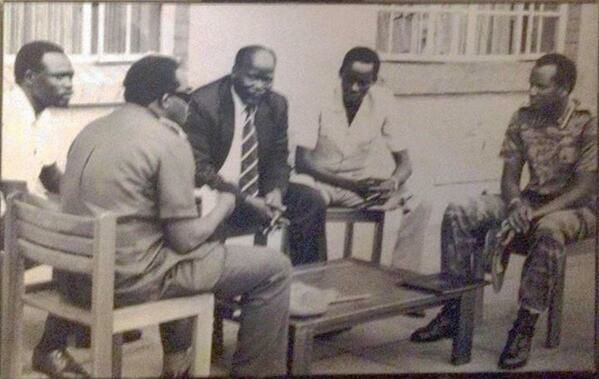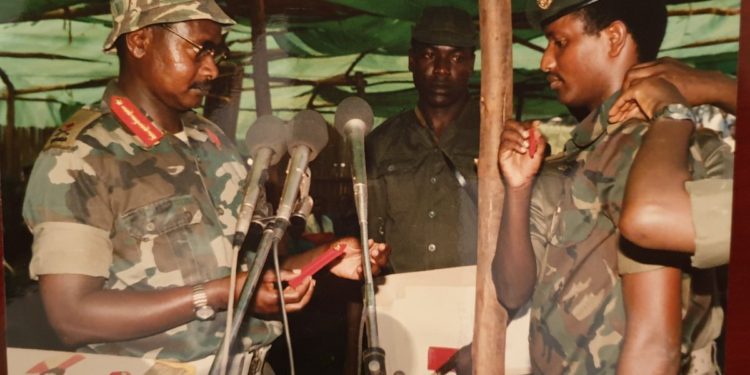To be a soldier, Rupert Everett once said, “one needs that special gene, that extra something, that enables a person to jump into one on one combat, something, after all, that is unimaginable to most of us, as we are simply not brave enough.” Not many soldiers’ exploits have attracted immense interest as that of Fred Rwigyema. In part two of our series, ‘Fred Rwigyema: In Memoriam’ we bring to you Museveni’s memories of the gallant soldier’s death.
BY FAUSTIN MUGABE
For almost two weeks, President Yoweri Museveni was kept in the dark by his security chiefs about the death of his veteran soldier and Deputy Defence minister, Major General Fred Gisa Rwigyema, until he returned to Uganda.
The President had travelled to the United States of America and Europe, having left on September 27 and returned on October 10, 1990.
In New York, Mr Museveni addressed the United Nations General Assembly as the Chairman of the Organization of African Unity (OAU), now renamed the African Unity (AU).
However, back home, Major General Rwigyema had led some 2,500 Banyarwanda officers and noncommissioned officers in the Uganda’ s National Resistance Army (NRA) attack Rwanda on October 1, 1990.
But tragedy soon struck. Just a day after the attack, Rwigyema, a veteran fighter and charismatic military leader of the invading Rwanda Patriotic Front (RPF), was killed on the battlefront, but this was kept secret.
Rwigyema was killed on October 2, 1990 about two miles from the Uganda-Rwanda common border at Mirama-Kagitumba. Secret as the death was kept away from the commander-in-chief, President Museveni claims he had a premonition of the tragedy, only days after Rwigyema had had been killed.
In the second edition of his book, Sowing the Mustard Seed, on page 280, Museveni writes: “I pity people who say that there is no God. I know that He is there, not because of what the Bishops and their juniors keep saying but because of my personal experiences. One of what I regard as God’s message happened to me in Copenhagen [Danish capital] on my way back from the USA, following the entering into Rwanda by the RPF.”
Museveni, who has held onto the presidency for close to 40 years writes on, “I had a series of European trips that had been arranged to follow my work at the UN and in Washington. Our visit was to Denmark where we arrived and stayed in one high-rise hotel whose name I do not remember. As usual, when we visit, our hosts take us on trips. I think we were driving towards a farm or something like that, together with [First Lady] Janet in the back of the car, when on account of fatigue because of hectic programmes, I started dozing off.”
All of a sudden, he shares, “I startled from my brief sleep by seeing in a dream (or was it a vision?), somebody with a sharp, shining knife, standing behind Janet as she sat facing the other way. He was aiming the knife at her breast as if he intended to cut it off! Somebody trying to cut off Janet’s breast! My mind straight away went to our young children – especially the girls, Natasha, Patience and Diana, who used to commute from Entebbe to Kampala Parents School every day. Something bad may have happened to the children or was about to happen to them, I thought in my mind. I did not, however, tell Janet; nor did I try to stop the trip to the farm. In those days, there were no mobile phones. I, therefore, took the first opportunity to go back to the hotel and telephoned Kampala in order to find out what was happening to the children.”
He adds, “Nothing wrong had happened to the children. Even Muhoozi at Budo was all right. Who, then, was this that was trying to cut off Janet’s breast? Obviously, breast meant motherhood. I only found out when I arrived back in Entebbe, after a prolonged trip. It was Rwigyema that I had, obviously dreamed about. In fact, by that time, Rwigyema had long died but our people had not wanted to tell me. This is not the first time God had used dreams or other signs to alert me of certain events – bad or good.”

WHO WAS RWIGYEMA?
1976: While in Senior Two at Mbarara High School was recruited into Front for National Salvation (Fronsa).
1976-1978: Was in the famous Montepuez Group of 28 men from Uganda who undertook a two-year commando training in Mozambique.
1978: Was in the original and first Fronasa platoon of 40 fighters before mass recruitment started at Kyaka in Tanzania near the Uganda border.
February 1979: Was among 300 Fronasa fighters who captured Western Uganda Axis after Mbarara had been seized and advanced through FortPortal and Masindi up to West Nile.
1980: Denied chance to join Uganda National Liberation Army (UNLA) for being a Rwandan and Yoweri Museveni kept him as his driver and bodyguard on a personal arrangement.
February 6, 1981: Was among 34 men who left to be joined by other soldiers during the attack of Kabamba military garrison.
May 1981: When the rebels’ number increased to about 200 fighters and units were established, Rwigyema was given the Mondlane Unit to command.
1982: Rwigyema and Salim Saleh commanded the First Mobile Force whose role was to launch offensive operations and also give support to other forces overpowered.
1984: Led the Safari Rwenzori, which was the evacuation of the sick, old and wounded fighters and civilians from Bulemeezi in central Uganda to Mountain Rwenzori in western Uganda.
February 1986: Member of the 33 historical National Resistance Council, Uganda’s first Parliament under the National Resistance Movement (NRM) government.
February 6, 1988: Commissioned Major General and appointed deputy army Commander.
November 26, 1989: President Museveni relieved him of duties as the Deputy Defence minister and offered to do a military course in America but did not go, instead Paul Kagame (now president of Rwanda) travelled for the course.







